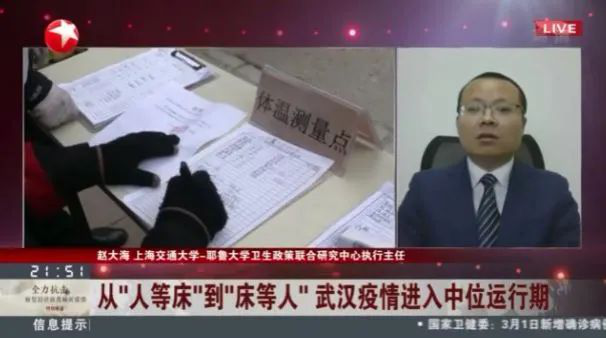
上海交通大学国际与公共事务学院博士生导师、上海交通大学-耶鲁大学卫生政策联合研究中心执行主任赵大海,自新冠肺炎疫情以来第十次接受电视台直播采访,包括五次央视英语频道和五次上海电视台的直播评论。在2020年3月2日晚9点30分东方卫视《全力抗击新型冠状病毒肺炎疫情特别报道》节目,赵大海就有关武汉市新冠肺炎防控的最新进展进行了直播评论。
主持人:对于武汉的疫情,中央指导组副组长陈一新昨天有个全新的判断,认为武汉疫情态势已经从高位运行期进入中位运行期,您怎么看?
赵大海:我认为这个判断是比较准确的。2月15号之前的半个月每天都是超过一千例;2月15日之后的这半个月,每天确诊病例在几百例,最新的数据是193例。与此同时, 2月19日武汉市完成全市拉网大排查“疑似患者全部进行了核酸检测,密切接触者全部进行了隔离”;也就是说,过去十余天的每日新增确诊病例数是大排查之后的数据。因此,我们有理由相信,武汉市不仅现在确实是在中位运行,而且低位运行的时间也应该会即将到来。
主持人:目前这个阶段,武汉的疫情防控重点在哪里?
赵大海:首先是如何降低重症患者病死率的问题。目前重症患者病死率依然很高。下一步在治疗方案等各方面,可能还有待于进一步优化。当然,更重要的还是早发现早治疗,甚至是早一点将患者集中到定点医院去治疗。此外,尽可能缓解全市医务人员的长期高强度工作问题。在超高强度的连续长时间奋战在一线,武汉全市医务人员,包括从全国各地赶赴援助武汉的医务人员,都已连续奋战了一个多月,普遍面临体力和精神力的透支。因此,接下来,在保证疫情进一步得到控制的前提下,如何让全市医务人员的轮休,缓解医务人员的高强度工作,也将是工作的重点。
主持人:在实现"床等人"后,武汉在救治方面做了个位移,就是把原来方舱医院的患者向定点医院转移,这样的变化,对于提高治愈率,降低重症率会带来怎样的影响?
赵大海:方舱医院原本就是临时方案,是在武汉定点医院无法收治的前提下所采取的临时措施,是让定点医院腾出床位收治重症和危重症患者;目前随着出院人数的不断增多,收治入院人数的不断下降,将原来方舱医院患者向定点医院转移,也是必然的步骤。甚至,将来关闭所有的方舱医院,将患者全部集中到定点医院也是必然的趋势。在定点医院,原先收治的患者大部分是重症和危重症患者,医务人员水平、医疗技术水平、救治经验等都是方舱医院无法比拟的,因此这对于提高治愈率和降低重症患者死亡率必然具有重要的影响。
供稿单位:国际与公共事务学院
日期:2020年03月03日
Dahai Zhao' 10th comments on TV during the Pandemic: Epidemic Situation in Wuhan was Generally Alleviated, Future Efforts will Focus on Reducing Fatality Rate of Critically Ill Patients
Dahai Zhao, a doctoral supervisor of the School of International and Public Affairs of Shanghai Jiao Tong University, and the executive director of Shanghai Jiao Tong University-Yale University Joint Center for Health Policy, have been interviewed by TV live broadcast for the tenth time since COVID-19 epidemic, including five CCTV English channels and five Live commentary of Shanghai TV. At 9:30 pm on March 2, 2020, the program "Special Report on Containing COVID-19 with Full Efforts", Zhao made a live comment on the latest progress in the prevention and control of COVID-19 in Wuhan.
Anchor: Chen Yixin, deputy leader of the Central Steering Group, had a brand new judgment yesterday, thinking that the situation of the epidemic in Wuhan has entered a mid-operation period from a high-level operation period. What is your opinion about this judgment?
Zhao: I think this judgment is accurate. In the later half of February, there were hundreds of confirmed cases every day, and the latest data was 193 cases. At the same time, on February 19 in Wuhan, the citywide network investigation was completed. “Suspected patients have been tested for nucleic acids and all close contacts have been isolated.” In other words, the number of newly diagnosed cases in the past ten days is the data after the big investigation. Therefore, we have reason to believe that Wuhan is not only operating at the middle position, but the time of low position operation should be coming soon.
Anchor: At this stage, what is the point of epidemic prevention and control in Wuhan?
Zhao: The first is how to reduce the mortality of emergency and severe cases, which is still very high. The next step may be to further optimize the treatment plan and other aspects. Of course, it is important to detect and treat early, and even to concentrate the cases earlier in the designated hospital for treatment. In addition, the long-term high-intensity work of medical workers in the city should be alleviated as much as possible. In the high-intensity continuous long-term battle in the front line, medical staffs in Wuhan, including medical staffs who have come to assist Wuhan from all over the country, have been working for more than a month, and most of them have faced physical and mental overdrafts. Therefore, for the next, under the premise of ensuring that the epidemic situation is further controlled, how to make medical staffs have holidays by turns and relieve the high-intensity work of medical staff will be the point of containing work.
Anchor: After the beds were vacated, Wuhan made a displacement in the treatment, which was to transfer the patients from the original Fangcang hospital to the designated hospital. What kind of impact will this change have on improving the cure rate and reducing the severity?
Zhao: The Fangcang hospital was originally a temporary plan. It was a temporary measure taken under the premise that the designated hospital in Wuhan could not work for more admissions. It was to make the designated hospital free up to treat emergency and severe cases. At present, with the continuous increase in the number of discharged patients and the continuous decline in the number of admitted patients, it is also an inevitable step to transfer patients from the Fangcang hospital to the designated hospital. In addition, it is an inevitable trend to close all Fangcang hospitals in the future and concentrate all cases in designated hospitals. In the designated hospitals, most of the patients originally admitted were emergency and severe cases. The medical technology and treatment experience of medical staff were much better than Fangcang hospitals’. Therefore, this plays a positive role on improving the cure rate and reducing the mortality of emergency and severe cases.
Contributor: School of International and Public Affairs, SJTU
Date: March 03, 2020

